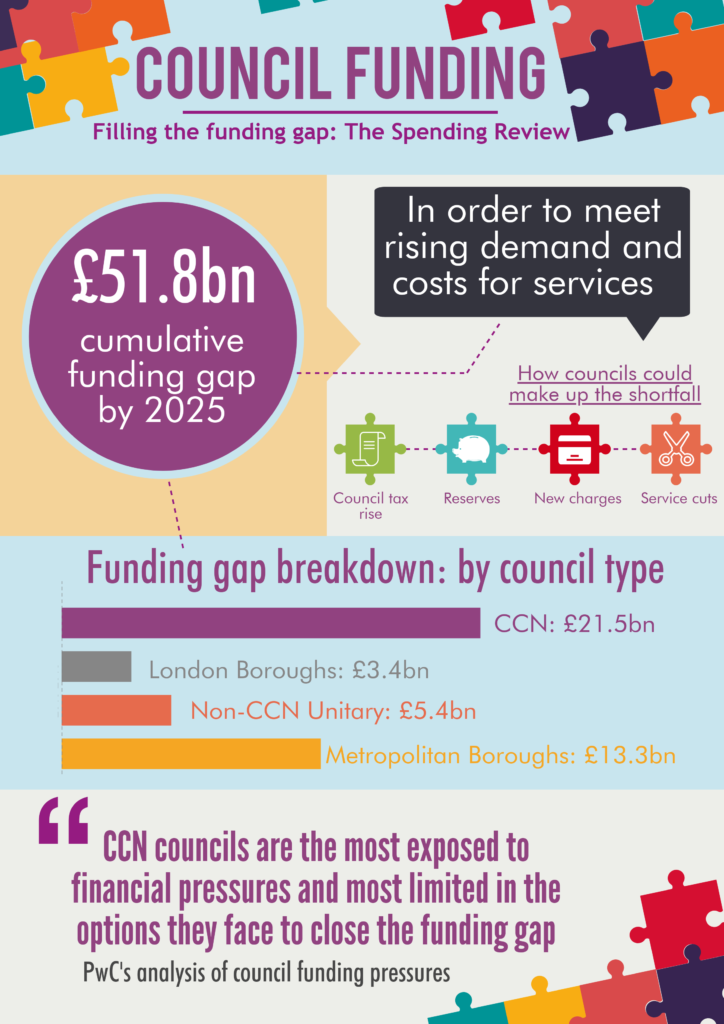Councils in England could face a funding black hole of over £50 billion over the next six years, with local authorities warning they will have to resort to providing the ‘bare minimum’ if no extra funding is made available.

An independent analysis of councils’ financial sustainability up to 2025 from PricewaterhouseCoopers LLP (PwC) for the County Councils Network (CCN) has found that rising demand for services and rising costs, driven in part by inflation, could contribute to councils needing an additional £51.8 billion of funding over the period 2019-2025.
Less than three weeks after the Environment Agency warned that expenditure on UK flood infrastructure will need to rise to £1 billion per year to tackle the growing impacts of climate change, it is not clear whether the potential gap could have implications for flood defence funding.
Under the Flood and Water Management Act 2010, County and Unitary Authorities became Lead Local Flood Authorities (LLFAs). From 2016-17, the Local Government Financial Settlement provides the majority of funding to Lead Local Flood Authorities to carry out their duties under the Act and they no longer receive a separate grant from Defra. The funding has been supplemented by a separate section 31 grant which makes good the Government’s commitment to protect the level of funding in real terms throughout this Parliament.
Revenue and non-grant eligible expenditure by local authorities is supported by formula grant from the Dept for Communities and Local Government (DCLG), but it is not ring-fenced for flood and coastal risk management. Individual authorities can decide how much to spend, subject to limits on overall budgets and the need for investment on other priorities.
Within the PwC - Independent Review of Local Government Spending Need and Funding, flood defence provision is subsumed within the spending category Environment and regulatory services, consisting of:
- Waste collection services
- Waste disposal services
- Recycling
- Rest of environment and regulatory services
According to the PwC analysis, in the baseline year (2015/16) spending on environmental and regulatory services accounted for 11% of total spending need of local government. Within this service area, 40% of spending by local authorities was on waste disposal services.
Over the 10 year period to 2024/25, spending on environment and regulatory services is expected to increase by 28%. CCN authorities would see their spending on environmental and regulatory service increase by 26% (around £350 million) over the same period.
The County Councils Network is today warning that yearly council tax rises, using their reserves, and making services more efficient and productive, will not be anywhere near enough to fill the funding gap; which means that councils will have to set out further rounds of ‘draconian’ cuts to local services, providing a basic, ‘bare minimum’ core offer to residents.
The network argues that even taking these actions will not be enough to prevent some councils from being unable to manage their budgets with the scope for savings narrowing each year.
Importantly, filling this funding gap only keeps services ‘standing still’ – rather than improving or enhancing them, nor reversing the last nine years of cutbacks. If councils raise council tax by 2.99% each year, the cumulative funding gap will still be over £30 billion. This methodology assumes government continue will give councils the flexibility to raise local council tax bills by 2.99% – this has not been confirmed.
County leaders, who run some of England’s largest councils, argue that today’s report from PwC demonstrates the need for government to provide councils with a significant funding boost in this year’s anticipated Spending Review over the next three years or provide immediate clarity and emergency funding for next year if the review is delayed owing to Brexit uncertainty.
The funding gap for this current year alone stands at £4.8 billion.
PwC’s analysis found that county authorities, which make up 46% of England’s population, face the largest funding pressures and are most exposed to financial risk – with limited ability to raid reserves or to raise fees or introduce charges for certain services.
The report also outlines that those counties bear the brunt of funding pressures into next decade, fuelled by rising costs for delivering services and rising demand for them. The funding gap facing those 36 areas over the six-year period amounts to £21.5 billion, 41% of the total. Metropolitan boroughs make up £13.3 billion, 25% of the total, and London boroughs just 7% or £3.4 billion.
Even if county authorities raised their council tax by 2.99% – and in addition their tax base grew at an optimistic rate of 1.98% per year over the six-year period it would only eradicate less than half of
Cllr Paul Carter, chairman of the County Councils Network, said:
“Over the last decade councils have played a crucial part in reducing the deficit, but the yearly compounding effect of funding cuts and rising demand means that the situation is fast becoming untenable. This research demonstrates the need for government to provide all councils with additional resources at the Spending Review, with the most significant financial challenges being experienced by county and metropolitan authorities most in need.
“Today’s report concludes that counties are most exposed and least able to address these financial pressures – local government is at the limit of its elasticity. Therefore, this Spending Review is crucial if we are to protect and enhance services.
“If government does not provide additional funding for councils over the medium term, many local authorities will resort to providing the bare minimum, with many vital services all but disappearing, particularly preventative services. Even these draconian cuts won’t be enough for many well-run councils to balance the books and it will leave our finances in disarray with many of us struggling to deliver even the basic level of local services.”
Government is currently undertaking ‘fair funding review’ of council funding which is planned for implementation early next year
The Government is currently undertaking a review of council funding – called the ‘fair funding review’ – which is planned for implementation early next year. CCN argues that the review must begin to eradicate the ‘historic underfunding’ of counties.
The report, which has been released today, also reveals:
- Only 11% of the cumulative funding gap nationally from 2020 could be plugged using council ‘rainy day’ reserves. For shire county councils this figure falls to just 7%. CCN said that reserves in no way could, or should, be used to fill funding shortfalls and councils are already at a severe financial sustainability risk, with counties most exposed.
- By 2025, four fifths (78%) of the 36 county authorities’ spending will relate to four key service areas; adult social care, children’s services, public health and education services (home to school transport & special educational needs). Spending on these services for the rest of the country’s councils will make up 68.5% of their spend.
Simon Edwards, director of the County Councils Network, said the research laid bare “the stark reality facing the sector and severe financial challenges now being felt by all types of councils”, commenting:
“The modelling undertaken by PwC is the most advanced and detailed to date. They looked at more than 17 different cost drivers across 10 local government services, alongside the impact of other rising costs on council budgets such as inflation and the living wage.”
PwC’s analysis is based on the funding required for councils to provide a ‘more consistent level of service by adjusting local authority level unit costs when estimating ‘spending need’. PwC’s modelling makes a series of future funding assumptions from 2020 onwards.
The quoted £51.2 billion figures does not include any rise in council tax rates from 2020 onwards, however, it does include an annual 1.98% increase in base growth (i.e. additional homes).
Click here to download the Executive Summary report PwC - Independent Review of Local Government Spending Need and Funding
Click here to download the report in full

 Future Water Association, a leading organisation driving transformation within the water sector, has announced the recipients of its esteemed awards, recognising the outstanding people contributing to the industry.
Future Water Association, a leading organisation driving transformation within the water sector, has announced the recipients of its esteemed awards, recognising the outstanding people contributing to the industry.

 What is to be done about the UK’s failing utilities? Listen to Professor Dieter Helm explore the options to tackle the UK’s failing utilities – Thames Water, the Royal Mail and Network Rail in particular.
What is to be done about the UK’s failing utilities? Listen to Professor Dieter Helm explore the options to tackle the UK’s failing utilities – Thames Water, the Royal Mail and Network Rail in particular.